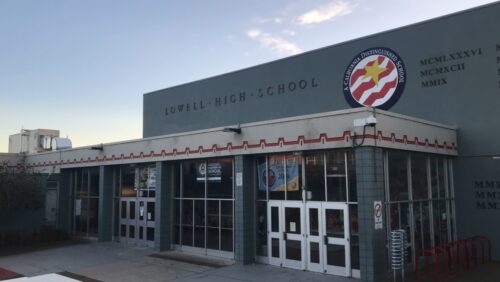Elimination of Merit Admissions at Lowell Advances Debate on Equity
By Loretta Bonifacio
History tends to repeat itself at the San Francisco Unified School District (SFUSD). Despite measures to desegregate schools, SFUSD admits that segregation rates have actually increased over the past 30 years.
In 1937, redlining maps were created for use in San Francisco and other cities in the Bay Area. This practice denied borrowers of credit, solely basing the decision on where an owner lived and the socioeconomic classification of their neighborhood. Because redlining was an inherently racist assessment of a neighborhood’s financial risk, this formally predicated the resource disparities that would later emerge at SFUSD.
Despite the 1954 federal ruling in Brown v. Board that defined school segregation as unconstitutional, San Francisco schools were mostly segregated during the 1960s. Growing resentment and hatred of Black, Asian, and Latinx students contributed to this deliberate separation. One racial group often comprised a school’s majority, until 1971.
Spanning 1971 to the present, SFUSD employed five different plans to desegregate San Francisco public schools: The Horseshoe Plan/Operation Integrate, Educational Redesign, Optional Enrollment Request (OER) Student Assignment System, Diversity Index Lottery, and the current Student Assignment System.
What the five plans have in common was their ability to work for a limited time, until another set of unique social challenges dated them. For example, busing’s attempt at racial balance became one-sided in the 1970s. SFUSD Student Assignment Project Manager Henry O’Connell explained that while Black children from Bayview/Hunters Point would attend schools outside their neighborhood, non-Black children wouldn’t be bused into Bayview schools. Simultaneously, families exploited the temporary attendance permit by finding loopholes to choose their children’s school assignment. The freedom of choice was not always a good thing and allowed families to actively segregate.

What does this imply today? This history enters a new chapter at Lowell High School. After the San Francisco Board of Education voted to permanently drop Lowell’s long standing, merit-based admissions system on Feb. 9, concern over its impact remained a contentious talking point.
When anti-Black and anti-Semitic messages were posted to Lowell’s Padlet website at the end of Jan. 2021, swift action was taken. Resolution No. 212-2A1 to amend Lowell’s policy was released on Feb. 2, followed by a rally hosted by the Black Student Union (BSU) on Feb. 5.
BSU’s rally for cultural reform at Lowell mirrored the group’s 2016 walkout, which was called in response to microaggressions and full-blown acts of hatred on campus.
Initially, the lottery system was introduced only for the 2021-2022 year as a short-term solution to the logistical admission challenges imposed by COVID-19. The board’s vote was met with dismay from some community members, who saw it as a threat to Lowell’s reputation and tradition.
The lottery admissions policy is scheduled to take effect at the beginning of the 2021-2022 school year. This means standardized test scores and middle school GPAs will no longer determine a student’s high school placement.
A student assignment system, referred to as a “lottery”, will take its place, effectively leaving the decision to chance. Families can also choose to reenter the lottery. Of the 15 public high schools in the district, Lowell was one of two schools left with selective admissions processes; the other is the Ruth Asawa School of the Arts (SOTA).
A minority within a minority, Lowell’s BSU is one of the few cultural clubs on campus. In 2016, the California Department of Education reported that Black students accounted for less than 1.9% of Lowell’s student body. For reference, Asians constitute 56.7%, Whites 15.2%, Hispanics 9.9%, Pacific Islanders 0.9%, and American Indians 0.3%.
BSU Co-President Shavonne Hines-Foster was one of two SFUSD student delegates to vote on the resolution. Hines-Foster has consistently pushed Lowell to denounce prevalent racism in the community, as demonstrated in the group’s demands for 2020-2021.
Hines-Foster and the BSU published a list of 23 demands, which primarily called for the passage of Resolution No. 212-2A1. Other key demands included establishing an application day for current Black students to support prospective Black students, along with presenting a zero tolerance policy on racism and discrimination at freshmen orientation.
Change, while inevitable, takes some getting used to. Ask Lowell’s affiliated organizations, which responded to the ruling in two different ways.
Lowell’s Parent Teacher Student Association (LPTSA) hasn’t provided a definitive statement on the resolution, but LPTSA President Tiffany Abuan clarified that “the passion and energy isn’t about the [Board of Education’s] decision, but about the lack of community input.”
“We advocate for restorative, not punitive approaches,” Abuan said. “We provide information about how to advocate, not what to think.”
Abuan added, “Our goal is to support students and if we aren’t doing that, we create a path to get there in conjunction with administration and alumni.”
The path ahead meanders when remarks from the Lowell Alumni Association (LAA) are taken into account. Their conviction is firm and their reasons abundant for opposing the lottery system.
A Feb. 8 statement published on LAA’s website claims that “an academic-based admissions system is incompatible with diversity, equity, and inclusion,” because the responsibility falls on SFUSD to provide students with more “resources and support needed to excel academically.”
Moreover, LAA considers how lottery admissions would compromise the school’s ability to offer an academically rigorous education for students most qualified to receive it.
When reached for public comment, representatives from BSU and LAA were unavailable.
A Change.org petition is circulating to urge SFUSD to explore alternative admissions policies at Lowell. Families for San Francisco started the petition in Oct. 2020. It has collected over 11,600 signatures.
Dialogue around Lowell’s admissions process may never cease and the lottery system may pose new challenges, but possibilities abound when we innovate what no longer serves us. Real social change only happens when strategic, community-based action incorporates feedback from its most oppressed constituents. Attention is the greatest currency we can pay to adequately meet each moment and every single one thereafter.
